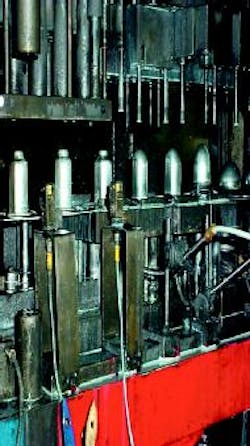Fluids fix power-window part problems
In its automotive power-window component press operations, F&G combats dermatitis and problematic residue with a combination of fluid products from Oak International.
With a lot of U.S. shops losing work to foreign competition, F&G Tool Die Co. in Dayton, Ohio, was pleasantly surprised when a customer wanted to bring a production job that was being done offshore back to the United States. The job involved motor housings for auto and truck electrical power-window systems, and F&G had to produce six million of them annually, with a projected goal of 15 million/yr.
The housings measure 3.5-in. long and 1.5 in. in diameter. Two magnets bond to the housing sides and create a magnetic field for the electrical power.
F&G's sister company, F&G Multislide in Franklin, Ohio, forms the housings in a 13-station progressive die mounted in a mechanical alternative slide press. This press accommodates deep draws with its slower downstroke than upstroke, and parts feed from right to left.
From the job start, this system generated perfect housings. However, the metalworking fluid F&G used irritated (dermatitis) the skin of employees and left a residue that stuck to housings even after they passed through a washing and rinsing process. Because of this residue, critical bonding between the interior walls of housings and magnets failed, meaning no magnetic field and no electrical output. To combat both the dermatitis and residue, F&G switched from the synthetic fluid it was using to a combination of products from Oak International.
In its stamping operation, the shop runs Oakflo DSO 6600, which eliminates employee skin rashes and dermatitis and keeps parts cool.
With the previous fluid, housings came off the die at about 220° F. Now, the Oak fluid and a spray system keep temperatures down around 160° F.
For parts washing, F&G combines Oakspec D1210RR, an acid cleaner, and Oakwash DMA2350, an alkaline cleaner. With the acid cleaner, oil residue in the wash tanks pops to the surface, where it is easily skimmed away. It also etches part surfaces for the matte finish the customer wants.
"Originally, we had to change the tank at least every two or three days," says Joe Koelker, production supervisor at F&G. "Now, it's done at annual maintenance time. We just maintain the proper concentration and skim the surface for an hour each day to remove oil."
However, he says, the shop does change its rinse tank every day. In this tank, Oakwash and a neutral acid thoroughly clean parts and retain their desired matte finishes. But most importantly, all the Oak products working together keep residue from causing magnet-bonding failure.
cimcool.com
